Thermal head for heating radiator: device, functioning + installation procedure
A device such as a thermal head for a heating radiator is designed to adjust the heating temperature. With its help, it is possible to more efficiently spend the coolant and save money.
The guaranteed effect of use is the right choice. To do this, you need to have a maximum of information about these devices.
From this article you will learn about the existing types of thermal heads, the device, the principle of operation and the rules for their installation on radiators. We will also give the main criteria that influence the choice, and briefly consider the best manufacturers of such equipment.
The content of the article:
Features of the structure of the thermal head
The most popular thermal head consists of a body, a bellows, a locking element, a pusher, a rod (locking cone), a return spring, sealing and fastening elements.
The amount of coolant passed into the radiator controls the valve device. This item complements most products.
The case is made of plastic by hot stamping. It can be either transparent or color - from white to black. The bellows is made of brass or galvanized steel. In most models, a thermal head housing for mounting on radiators and thermostatic valve compatible.
The highest rate of reaction to temperature fluctuations is possessed by such a bellows filler as gas condensate.
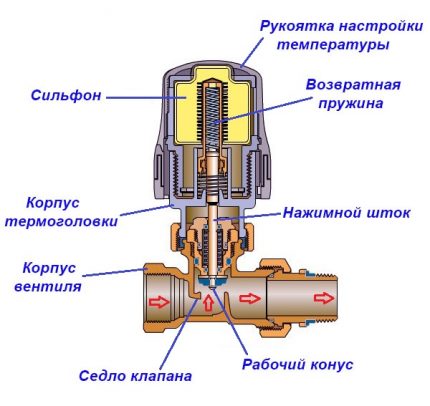
On the case at the very top is a locking element. It is necessary to fix the settings.If the settings have not changed for a long period or if the movable elements of the device are inactive, they can stick.
To combat this phenomenon, experts recommend dismantling the thermal heads from the valves as soon as the heating season ends. When thermostatic valves are designed for pressure from 4 atm, the likelihood of sticking is significantly reduced.
There is such a thing as a "gestosis" of the head. The smaller it is, the faster the response of the device to temperature changes.
Types of thermal heads and the principle of their work
Thermal heads belong to shutoff and control valves.
There are three types of thermostatic heads:
- hand held;
- mechanical;
- electronic.
The functions are the same in all, but the implementation methods are different. Depending on the last parameter, they have different capabilities.
What are manual thermal heads?
By design, thermostatic heads duplicate a standard tap. By turning the regulator, you can adjust the amount of coolant transported along the pipeline.
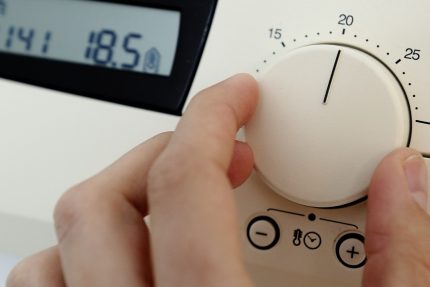
Mount them instead ball valves on opposite sides of the radiator. They are reliable and inexpensive, but they will have to be controlled manually, and turning the valve each time, relying solely on their feelings, is not very comfortable. Basically, such thermal heads are installed on cast-iron batteries.
If the valve stem is switched several times a day, the valve flywheel will weaken. As a result, the thermal head will quickly fail.
Features of mechanical thermal heads
Thermal heads of a mechanical type have a more complex structure and they maintain the set temperature in automatic mode.
At the heart of the device is a bellows in the form of a small flexible cylinder. Inside it is a temperature agent in liquid or gaseous form. As a rule, it has a high coefficient of thermal expansion.
As soon as the set temperature indicator exceeds the norm, under the influence of the internal environment, which has greatly increased in volume, the stock starts to move.
As a result, the cross section of the passage through the thermal head narrows. In this case, the throughput of the battery decreases, and, consequently, the temperature of the coolant to the set parameters.
As the liquid or gas cools in the bellows, the cylinder loses its volume. The rod rises, increasing the dose of coolant passing through the radiator. The latter is gradually warming up, the balance of the system is restored and everything starts all over again.
A positive result will only be when thermostats are available in all rooms and on each radiator.
More popular are devices with fluid filled bellows. Although the reaction of gases is faster, the production technology is rather complicated, and the difference in measurement accuracy is only 0.5%.
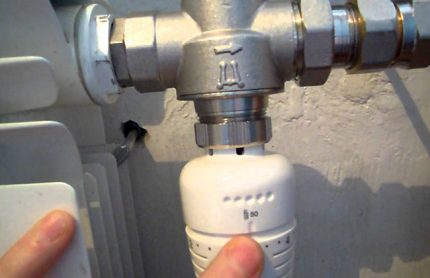
The thermostatic head is mounted so that it is oriented towards the room. This will increase the accuracy of temperature measurement.
If there are no conditions for such an installation, mount a thermostat with an external sensor. A capillary tube with a length of 2 to 3 m connects it to the thermal head.
The feasibility of using a remote sensor is due to the following circumstances:
- The heater is placed in a niche.
- The radiator has a depth of 160 mm.
- The thermal head is hidden behind the blinds.
- A large width of the window sill above the radiator, while the distance between it and the top of the battery is less than 100 mm.
- The balancing device is located vertically.
All manipulations with the radiator will be performed with orientation to the temperature in the room.
What is the difference between electronic thermal heads?
Since, in addition to electronics, such a temperature controller has batteries (2 pcs.), It is larger in size than the previous ones. The stock moves here under the influence of a microprocessor.
These devices have a large set of additional functions. So, they can set the temperature by the clock - at night the room will be cooler, and by morning the temperature will rise.
It is possible to program temperature indicators for individual days of the week. Without reducing the level of comfort, you can significantly save on heating the house.
Although the battery charge is sufficient for operation for several years, they still need to be monitored. But the main minus is not this, but the high price of electronic thermal heads.
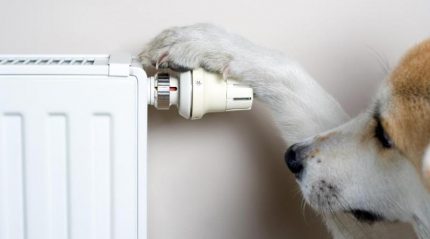
If installed on the radiator decorative screenThe thermal head will be useless. In this case, you need a controller with a sensor that records the external temperature.
Thermal head installation rules
The connection point when installing the thermal head on the radiator does not depend on its type. In any case, this is a pipe that directly supplies the coolant to the battery.
In order for the device to work correctly, air must circulate continuously around it.
Connection Recommendations
Each manufacturer gives recommendations regarding the connection of a thermal head.
Despite this, there are general conditions for installation:
- The case must be protected from direct ultraviolet rays. Otherwise, the device will not work accurately.
- The thermal head should be open. It should not be hidden by any protective boxes, furniture.
- The device must not be above the heating pipes. In this case, there will be a mismatch between the room temperature and the area around the head.
- If the device is practically isolated, you need to arrange bypass line or put a bypass valve in the area of the supply pipe and return.
- The connecting pipe must not exert pressure on the valve body.
During installation, the thermal head regulator must be set to maximum. This will ensure the correct operation of the device. Just before installation, the movement of water or other coolant in the circuit you need to overlap, then drain.
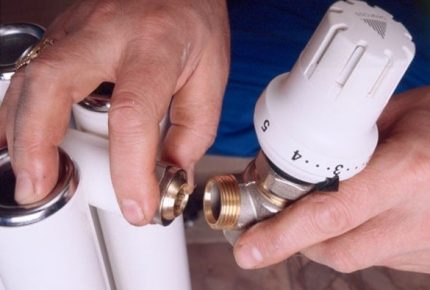
Instrument Installation Sequence
Installation must begin with pipe trimming, which is performed by stepping back slightly from the radiator. The next step is to dismantle the existing valves. Next, the shanks are separated from the valves and screw them into the radiator plugs.
Mount the piping in place, after collecting it, connect the pipes. It remains to adjust the temperature by turning the thermostat knob until the notches match the existing marks on the case corresponding to a specific temperature.
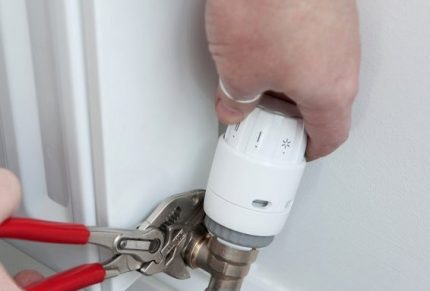
It is important that the arrow on the housing points toward the flow of hot fluid in the system. Otherwise, the work is done in vain, nothing will work. A thermal head can be installed both at the input and at the output.
Manufacturers' recommendations regarding the installation level of the device should not be neglected, since it is calibrated for temperature at this height. Basically it is 0.4 - 0.6 m from the floor.
But not all batteries have an upper feed; it can also be lower. If there is no sample suitable for height, exit to setting the thermal head to a lower temperature.
Since the floor is cooler and the appliance is set to the temperature that should be at the top of the battery, the room will be hot. In order not to do this, you can install a thermal head with an external sensor. There is such an option as self-tuning the regulator.
Customization Features
For normal operation of the device, a preliminary setting is required. Before this, they turn on the heating and isolate the room by closing the door.
At a certain point, a thermometer is installed and the setting is started:
- Turn the thermal head to the left side to the stop so that the flow of the coolant is completely open.
- They wait until the temperature rises by 5-6 ° compared to the initial one.
- Turn the head all the way to the right.
- When the temperature drops to the desired value, the valve is gradually unscrewed. They stop rotation when noise appears in the radiator and the body warms.
The last position of the thermal head corresponds to a comfortable temperature. She will be constantly supported.
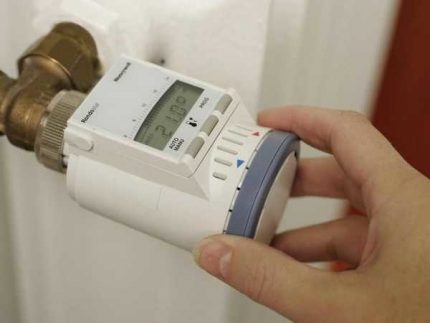
The described sequence is suitable for most devices. If it is different, then it is not difficult to complete it, since everything is described in detail in the passport.
What are the criteria for choosing a thermal head?
Thermostatic devices are produced by many manufacturers.
To make the right choice, you must be guided by the following criteria:
- Thermal valve to which the head will be attached. Since the connection can be clip or threaded, you need to pay attention to this point. If the manufacturer is the same, there will be no problems.
- Type of threaded connection on the head itself. It can be in the form of a nut with blinds or just round. In the first case, during installation, an additional tool is needed to crimp the connection. In the second - everything is much simpler.
- The presence of a "skirt". With her head looks better, because it closes the work area.
- Production material. The cheapest are thermal heads in a plastic case. For expensive models, the case is metal.
- Plastic quality. Some manufacturers, in order to reduce the cost of their products, use the cheapest type of plastic. The structural strength suffers from this, and over time, the plastic turns yellow and loses its aesthetic appearance.
- Work Item Type. The choice will have to be made between liquid, gas, electronic and paraffin.
- Rotation smoothness. The handle should rotate smoothly. This is a sign of good quality. All sorts of crackles, creaks and seizures indicate a poor quality product.
- Graduation and scale length. For most models, it is in the range +5 - +30 ° C. If the scale is located around the entire perimeter of the head, it can quickly be erased.
- The presence of an anti-vandal casing. It protects against unauthorized access to settings.
- Design. Since the thermal heads are mainly located in plain sight, their appearance and color scheme are important.
A complete set consisting of a thermal valve and a thermal head is optional. These devices can be purchased separately.

A thermal head equipped with automation wins a lot, but it is not always effective. It makes no sense to mount it on cast iron radiators. This material is very heat-absorbing, and since the mass of the battery is large, it has great inertness. Only the manual type of head can work correctly here.
Overview of Popular Brands
The right decision when buying a thermal head is to focus on reputable manufacturers. An unfamiliar trademark with an unknown history is a big risk to spend money in vain.
You can safely purchase products from manufacturers such as Dunfoss, Oventrop, Caleffi, Salus and other well-known companies.
Rank # 1 - Danfoss
For more than 60 years Danfoss has been manufacturing thermal heads. This is a Danish manufacturer; under his license, products are also produced in Russia.

The most commonly asked is the RTS Everis thermal head. This is a bellows product filled with a liquid. By direct fixation it is interfaced with branded thermal valves. For others, an adapter is needed.
Test existing types of brand thermal heads in the following video:
Rank # 2 - Oventrop Brand
Oventrop thermal heads from the Uni line are in great demand among consumers. They are equipped with a liquid bellows. They are connected to the thermal valve using a union nut. The temperature can be set between +7 - +28 ° C.
There is a possibility of complete closure. The heads are designed for the maximum temperature in the system +100 - +120 ° C - these are the characteristics indicated by the manufacturer in the accompanying documentation.
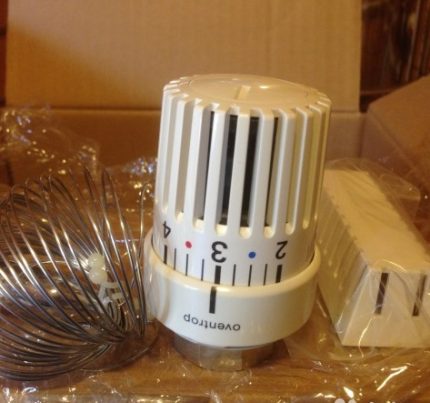
Install them on thermostatic valves with a suitable connection. On the heads of many series there is a special mark for people with low vision, an anti-vandal casing.
Rank # 3 - Thermo
High praise was given to consumers of Swiss Thermo products, in particular, the Royal Thermo RTE 50.30 model. It has a wide adjustment range - from +6 to +28 ° C, low hysteresis value - 0.55 degrees. There is a zero position.
For correct operation, the coolant must have a temperature of no higher than 100 ° C. Coupling with the valve - union nut.
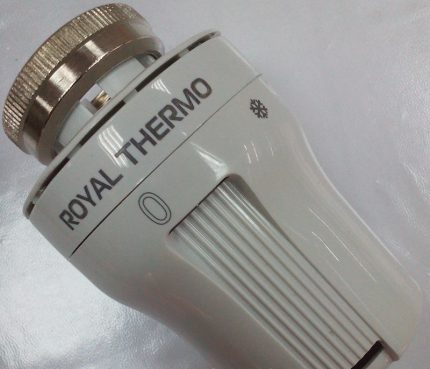
Rank # 4 - Caleffi Producer
The Italian manufacturer Caleffi supplies a wide range of radiator thermal heads. The Caleffi 210000 is programmable. It is equipped with a digital LCD temperature indicator. In addition to the temperature value, it shows the time, date, set daily program.
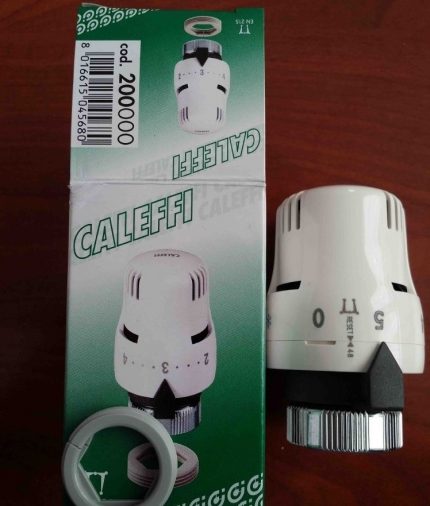
When programming for a week, you can set 3 temperature levels: “Comfort”, “Economy”, “Anti-freezing”. Install this head in tandem with Keleffi valves.
Place # 5 - Salus
The German company Salus also enjoys a well-deserved reputation. For example, the Salus PH 60 model is an electronic head with non-volatile memory, the ability to set the temperature regime for a week. Temperature range - +5 - +40 ° C.
Power is supplied from 2 AA elements. The display has the function of backlighting and displaying temperature parameters, as well as the charge level of the elements.

Technical innovations do not cease to please users - wireless thermal heads allow the owner to create a comfortable microclimate indoors, while being in the other end of the city or another country. And all this becomes possible if you integrate the device into the system smart home heating or download the proprietary application.
Conclusions and useful video on the topic
The device and purpose of the thermal head are described in detail in the following video:
Should I install a thermal head on batteries? This is described in detail by one of the users in his video review:
Thermostatic valve and head in action:
The heating circuit with a thermal head is more convenient to use. This device increases the life of the equipment included in the heating system, increases its fire safety.
Based on the benefits of these relatively simple devices and their 20-year life, their cost is low. To buy a product of really high quality, find out if there is a certificate for the selected device.
Do you use thermal heads for your heating equipment? If yes, then share your personal experience with installation and operation, add photos, tell us if you are satisfied with these devices and how much more comfortable the microclimate in your home has become after installing the thermal heads.
If you still have questions, then do not hesitate to ask them in the comment block - our experts and competent users will try to cover difficult moments as much as possible.

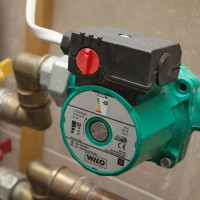 Connection diagrams of the heating pump: installation options and step-by-step instruction
Connection diagrams of the heating pump: installation options and step-by-step instruction 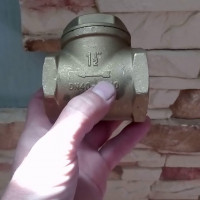 Check valve for heating: action, types, pros and cons + installation diagram
Check valve for heating: action, types, pros and cons + installation diagram 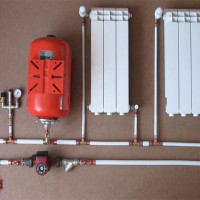 Expansion tank for closed heating: operating principle and device + how to choose and install in the system
Expansion tank for closed heating: operating principle and device + how to choose and install in the system  Expansion tank for open heating: device, purpose, main types + tips for calculating the tank
Expansion tank for open heating: device, purpose, main types + tips for calculating the tank 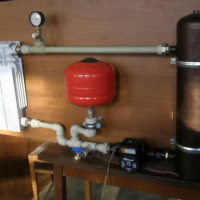 Expansion tank of the heating system: device, calculation and selection of the best option
Expansion tank of the heating system: device, calculation and selection of the best option  Selection of a circulation pump: device, types and rules for choosing a pump for heating
Selection of a circulation pump: device, types and rules for choosing a pump for heating  How much does it cost to connect gas to a private house: the price of organizing gas supply
How much does it cost to connect gas to a private house: the price of organizing gas supply  The best washing machines with dryer: model rating and customer tips
The best washing machines with dryer: model rating and customer tips  What is the color temperature of light and the nuances of choosing the temperature of the lamps to suit your needs
What is the color temperature of light and the nuances of choosing the temperature of the lamps to suit your needs  Replacement of a geyser in an apartment: replacement paperwork + basic norms and requirements
Replacement of a geyser in an apartment: replacement paperwork + basic norms and requirements
I want to put a thermal head for a heating radiator. The thing seems to be useful, but I had a lot of questions about it. For example, how accurately the temperature in the room is regulated, with what error? And does it depend on external factors? That is, is it necessary to regulate it if, for example, there is severe frost outside, or once you set the desired temperature and it keeps it regardless of the outside temperature?
By and large, "set and forget." Sometimes, of course, you have to tighten up, based on the subjective feelings of comfort. There is an error, it depends on many factors, but on the whole the temperature is kept approximately as you set. I have a thermal head with valves from Valtec, I am very pleased. The temperature is kept stable, does not jump.
Hello! Tell me, is it possible to replace the thermostatic solid-state head (6.5-27.5 ° C) VT.1000.0.0 with a Chinese thermal head with a TIM Industries remote sensor? The thread seems to be the same. And how to do it? Is it possible to twist them yourself? Is it mandatory to drain the riser?